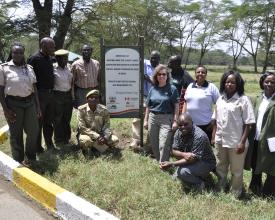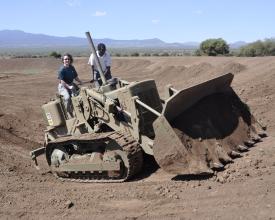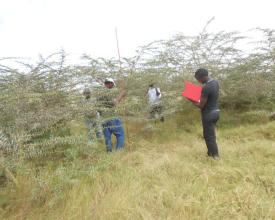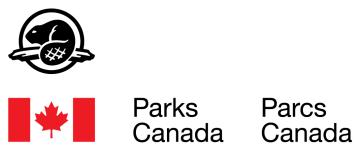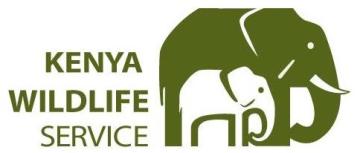
Park agencies collaborate to comprehensively tackle climate change impacts
Full Solution
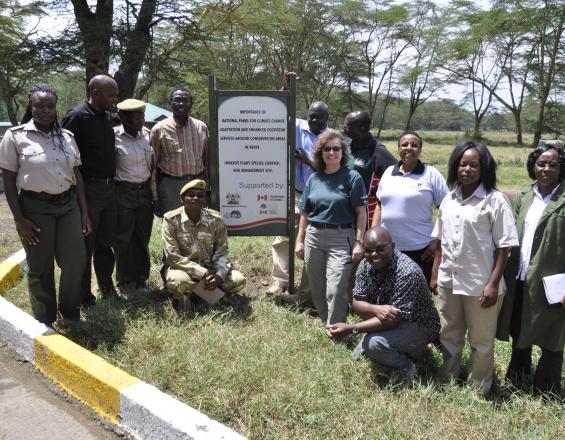
Project implementation team in Lake Nakuru NP
Interventions to enhance the adaptive capacity of six national parks and adjacent local communities to climate change impacts were undertaken in a collaborative partnership between the Kenya Wildlife Service (KWS) and Parks Canada. Initiatives focused on ecological restoration of degraded habitats, management of invasive species, enhancement of water supply for people and wildlife during the dry seasons, and capacity building for KWS staff and local communities
Last update: 06 Feb 2023
5160 Views
Context
Challenges addressed
ecosystem degradation, loss of biodiversity, and intense human wildlife conflict
The combined effects of prolonged droughts, reduced water availability, high concentration of animals in a few places with permanent water and an unprecedented spread of invasive species in prime national park habitats have resulted in severe and widespread ecosystem degradation, loss of biodiversity, low tourist appeal and intense human wildlife conflict.
Location
Kenya
East and South Africa
Process
Summary of the process
The purpose of the project was to enhance ecosystem and community adaptation to climate change. The collaborative partnership helped to create a common vision, agree on project design and implementation framework, identify capacity needs and define roles and responsibilities. Through collaboration and capacity building, it was possible to raise funds and tap into diverse skills that were necessary to initiate broad adaptation interventions in different parts of the country. The management of invasive species and ecological restoration of critical habitats were crucial for minimizing environmental stress, enhancing ecological integrity and increasing ecosystem resilience to climate change impacts. Protecting water sources and enhancing water availability during periods of scarcity enhanced the value of protected areas, improved relationships between parks and neighboring communities and reduced human wildlife conflict. Reducing conflicts also contributed to building meaningful partnerships for ecological restoration and other climate change adaptation strategies
Building Blocks
Engaging diverse partners to address climate change impacts
Creating a strong collaborative partnership was an important success factor for this project. A management planning workshop held in July 2011 and attended by KWS scientists, planners and managers and facilitated by Parks Canada identified climate change as the most important conservation challenge facing Kenya’s national parks. Six parks heavily impacted by climate change were identified for adaptation intervention and appropriate initiatives determined for each one of them. The implementation strategy required the project to engage diverse partners drawn from the public and private sectors. Local communities, researchers, NGOs, park visitors, school groups, the tourism industry, health workers, youth and women groups associated with each park were consulted by KWS, briefed on the project’s goal of enhancing adaptation to climate change, and requested to participate in its implementation. KWS and Parks Canada provided scientific and technical support while other participants contributed professional skills, local knowledge, labor and enthusiasm. The Government of Canada provided funding through the Fast Start Climate Change Initiative.
Enabling factors
• existence of a national climate change framework for Kenya was helpful in engaging stakeholders on issues of climate change impacts and the need for a societal response
• A strong and effective KWS community conservation programme facilitated outreach
• A formal partnership between KWS and Parks Canada executed through a Memorandum of Understanding facilitated acquisition of funds and provided an opportunity for sharing professional expertise to develop and implement broad scale adaptation interventions.
Lesson learned
• Dialoguing with people to create the awareness of climate change impacts on livelihoods and the role protected areas can play to address them can promote their willingness to participate in adaptation interventions.
• Implementing intervention actions together with diverse groups helped to increase the awareness and understanding of climate change impacts, the benefits of protected areas and healthy ecosystems in addressing climate change threats, and the need for collective and individual action in mitigation and adaptation
• A partnership such as the one between Parks Canada-KWS can be a model for interagency collaboration for addressing global challenges
Engaging citizens to control the spread of invasive species
Invasive species in Amboseli, Tsavo and Nakuru NPs had covered large areas of wildlife habitat, displaced native biodiversity, reduced favorable forage, affected wildlife distribution and lessened visitor enjoyment. In each park, KWS staff worked with local people and other scientists to identify invasive species, their impact on wildlife, strategies for early detection, and mechanisms for control and eradication. Special focus was given to species that were growing fast, breeding profusely, dispersing widely and outgrowing native species. Areas of heavy infestation were mapped and divided into blocks to enable systematic control. Mechanical removal was preferred over chemical-based eradication to minimize risks to non-target species. KWS organized volunteer groups from local institutions and communities to mechanically uproot invasive plants from designated areas. In some cases local people were hired to work in difficult areas. The uprooted trash was either burnt in abandoned quarries or buried to prevent re-invasion. Plots were revisited for three growing seasons and regrowth removed.
Enabling factors
• Many citizen groups showed willingness to participate in the eradication of invasive species
• There was plenty of local labor for mechanical control, a labor intensive method.
• A good understanding of the impact of invasive species existed at individual and community levels
• Traditional and expert knowledge was available for identifying invasive species and their impacts
• Sufficient funding was available to purchase the required implements, pay casual workers when necessary and to support logistics
Lesson learned
• Re-invasion was observed and complete eradication was only possible after three consecutive mechanical removal sessions spanning several growing seasons.
• Herbivores were immediately able to utilize cleared areas, but large predators were disadvantaged as stalking prey was more difficult in more open areas.
• Disposal of uprooted biomass can pose a significant challenge and should be planned for in advance
• Understanding the cause and mechanism of invasion can help in the eradication or containment of invasive species
• Providing free park entry to volunteers can be an initial incentive for volunteers to participate in invasive species control
• Communicating the success and challenges of invasive species control can attract additional support from stakeholders and donors.
Restoration of degraded habitats
Restoring degraded habitats aimed to enhance ecosystem resilience in five key national parks that collectively provide ecosystem services to more than half of Kenya’s population and rank among the top ten tourist destinations in the country. Restoration focused on areas already earmarked for rehabilitation in park management plans. Exclosure blocks approximately 100 ha in degraded areas were fenced off using solar powered electric fences to exclude wildlife and allow regeneration. Fence structure and design were based on site-specific conditions and the level of risk of damage by large herbivores. Seedlings from native species were provided by KWS, the local communities or purchased from the Kenya Forestry Research Institute (KEFRI) and planted within the exclosures to supplement natural regeneration. At least one modern tree nursery was established within each park and where possible, in the neighboring community areas to support long-term supply of seedlings. Interpretive signs were displayed at restored sites for public information. Game viewing tracks were extended to some of such areas to showcase the benefits of restoration.
Enabling factors
• Initiatives were supported by the Kenyan constitution and the country’s climate change strategy
• Outcomes of various ecological restoration experiments were available in project areas
• Funding was available for training, purchase of required facilities and to support project management
• Diverse expertise was available to carry out specialized tasks
• Communities and diverse sectors of the society, including the private sector were willing to participate in ecological restoration
• KWS was able to reach out to and engage diverse community and citizen groups
Lesson learned
• It is much easier to get support for ecological restoration when causes of degradation are well understood and the need for intervention incorporated in national park management plans
• Ecological restoration can be an expensive undertaking requiring planning, diverse resources and specialized skills for extended periods
• Some restoration methods such as those using electric fences may require specialized training for post project maintenance
• Participating in ecological restoration can provide people with the opportunity to experience and connect with nature and to discover the many benefits of protected areas.
• A champion to rally and inspire people to embrace ecological restoration may be necessary given the many competing societal priorities.
• Communities can contribute specialized skills, resources, free labor and other support if they are made aware of the benefits of ecological restoration
Enhancing water availability to reduce conflict
Wildlife in Amboseli and Tsavo national parks invade community lands during drought periods in search of water while people drive their livestock into the parks in search of pasture. These inverse wildlife-livestock movements usually result in intense human wildlife conflict. The project focused on creating water reservoirs in parks and community areas that could conserve rain water for 4-6 months into the dry season, allowing wildlife and livestock to utilize different parts of the landscape over longer periods and reducing the need for wildlife and livestock to cross park boundaries. Suitable areas for capturing rain water were identified and dams and water pans were excavated. These included rehabilitating some old dams that used to be fed from streams and rivers that had dried up. In addition, important swamps that provide water to wildlife and communities throughout the year were identified and fenced off to reduce degradation due to overuse. Water was pumped into water troughs constructed outside the fence to ensure sustained supply to people, livestock and wildlife. Trees were planted along the swamps to reduce soil erosion.
Enabling factors
• Funding was available to undertake relatively expensive excavations
• KWS and communities have good understanding of the hydrology of the land
• Cost of creating dams significantly reduced as KWS has technical knowhow, appropriate equipment and experience for undertaking the tasks.
• Good community and stakeholder support
Lesson learned
• Under climate change, it may be necessary for communities and park agencies to agree on mechanisms of sharing water resources during times of scarcity in order to prevent human wildlife conflict
• Localized environmental solutions such as swamp protection can yield enormous benefits to many people and prevent human wildlife conflicts at different geographical scales.
• Rain water harvesting can be a low cost strategy that can minimize water-related conflicts.
• Adaptation strategies that enhance the provision of ecosystem services while reducing resource use conflicts can attract support from diverse partners.
Formal and informal training for adaptation
As people cannot adapt to climate change without first having the capacity to do so, the project aimed at equipping a broad range of partners with knowledge and skills necessary for effective implementation of adaptation actions. The main target groups comprised KWS staff and local communities. Specific areas of training included methods and techniques of ecological restoration, management of modern tree nurseries, including seedling production and propagation. Others were reforestation techniques, invasive species identification, control and management, water quality and quantity monitoring, and fence maintenance. Training was provided at individual, institutional and community levels and was done either through formal institutions or on-the-job training. The Kenya Forestry Research Institute (KEFRI) provided specialized training to KWS and community groups in establishment and management of tree nurseries, reforestation, and invasive species management. Most volunteer groups received on-the-ground training from KWS staff and other relevant professionals and technicians
Enabling factors
• Funding availability
• Professional expertise in different areas available
• Support from organized community groups such as community forest associations, tour groups and learning institutions.
Lesson learned
• Capacity needs (in terms of skills) may vary between locations due to the differences in climate change impacts and differences in site-specific interventions
• Responding to climate change impacts require a great diversity of skills and resources which reside outside conservation agencies and can be tapped through collaborations and partnerships.
• Skills obtained through training were transferable to areas of human pursuit
Impacts
Protection of water sources and provision of more watering points in national parks and community areas increased water availability for people and wildlife, reduced human wildlife conflicts and minimized soil erosion. Rain water captured in dams is now available to people, wildlife and livestock 4-6 months into the dry season, reducing the need for wildlife to move out of parks into community land in search of water. Removal of invasive species has minimized biodiversity loss, availed more suitable habitat for wildlife and reduced conflicts caused when wildlife venture outside parks to seek better pasture. In addition, areas cleared of invasive species immediately attract grazers and improve wildlife viewing opportunities for visitors. Ecologically restored areas are showing tremendous recovery and will eventually provide improved wildlife habitats and increased supply of ecosystem services. Finally, capacity building enabled more effective project implementation while a collaborative partnership helped to pool resources, knowledge, experiences, skills and clout for broad implementation of adaptation actions.
Beneficiaries
Kenya wildlife service, farming communities, tourism industry, livestock industry, hydropower generating companies, and consumers of water in some rural and urban areas such as Nairobi and Mombasa
Story
Over the last ten years, the natural vegetation at the source of the Mzima Springs in Tsavo NP has been progressively degraded by elephants and other wildlife that concentrate at the site in their thousands during prolonged droughts. Besides providing life support for wildlife, the springs also supply over 300 million litres of water daily to about 3 million downstream communities, including to Kenya’s second largest city of Mombasa. The most urgent intervention was to halt further habitat degradation by cordoning off about 100 hectares of the source of the springs using a high voltage solar-powered electric fence. The fence was designed so as to allow hippos that live in the springs to move in and out while restraining other large mammals. Water was made available to wildlife several hundred meters downstream and more was pumped out into artificial water troughs built outside the exclosure to discourage elephants from breaking the fence. KWS engaged tourists, schools, local communities, decision makers and political leaders in planting tree seedlings to speed up the restoration process and reduce soil erosion. These activities helped to create significant awareness of the status of the springs, a situation that attracted media interest. The Kenyan Minister for Water Development, the Governor of Taita Taveta County and Members of Parliament became interested in the springs and publicly underscored their importance in boosting the local and national economies, and in reducing human wildlife conflicts. Multi-million dollar water development projects have been initiated by both the local and national governments to enhance water supply to many local and urban communities. Though the springs had remained largely unappreciated as an important source of water since 1953 when the colonial government laid down the water works, the project helped to elevate their status from only being viewed as a tourist attraction, but also as an important national resource that must be protected and secured for the well-being of millions of local and urban populations. Their role in providing an essential ecosystem service that is in high demand is helping to draw public attention to the non-conventional values of protected areas.
Connect with contributors
Other contributors
John Waithaka
Parks Canada / Kenya Wildlife Service
Edwin Wanyonyi
Kenya Wildlife Service
